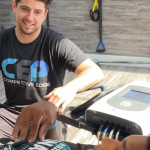
Heart Rate Variability (HRV) and Optimal Health
February is Heart Month!
Historically, heart health has been assessed by indicators obtained from routine bloodwork, blood pressure monitoring and physical stress tests. However, technology now allows us to look closer into the heart’s functionality, providing “insider information” on how the body is operating as a whole. While it may appear that the heart beats to a steady rhythm, a healthy heart actually changes its rhythm with each beat. This metric is termed “heart rate variability” (HRV).
Heart rate variability is a measure of the variation of time between your heartbeats. It’s a personalized metric that serves as one of the key indicators of your recovery status, overall health, and fitness level. It provides a snapshot analysis of your autonomic nervous system (ANS) functionality—directly relating to your body’s ability to turn on/off the fight or flight response. Your HRV can range anywhere from below 20 to over 200 milliseconds, and levels naturally fluctuate day to day. A key sign of health and recovery is a resilient HRV score that is able to rebound after taking a hit or gradually improves over time.
Heart Rate Variability (HRV) Diagnostics
CEP has integrated heart rate variability (HRV) technology into our practice to assess a client’s physical state. This non-invasive, 5 minute procedure paints a picture of the body’s wellness and recovery capacity by gaining feedback from electrical activity of the heart. Through analysis of this critical information, CEP can develop individualized plans to improve health status and increase functional capacity during fitness activities. In addition to assessing wellness in the general population, HRV diagnostics has also been utilized to demonstrate positive outcomes of physical therapy interventions in patients recovering from injuries when re-scanned throughout the course of treatment.
Changes in HRV can be seen in many scenarios:
- Long term stress: prolonged stress can cause HRV values to gradually drop, indicating that the body may need more recovery time.
- Impact of illness: Being sick can acutely drop HRV. If it remains low, even after symptoms disappear, it may be a sign that the body needs more time to normalize.
- Disrupted sleep: Jet lag or inconsistent sleep can put a strain on the body. Over time, this can impact the ANS and will be reflected in declining HRV.
- Overtraining: If you complete a hard workout, it can quickly lower HRV. In recovery, HRV will rebound. If HRV doesn’t return to baseline, training may be too hard or too often. The body may need more time to recover.
HRV and COVID 19/Illness Prediction
An emerging use of HRV data is in the field of illness prediction and monitoring the body’s state during an illness. Wearable technology from popular brands now allow individuals to assess their HRV throughout the day and correlate that data to overall recovery capabilities and susceptibility to “risks” such as illnesses and injuries. In fact, Apple recently released a study they performed at Mount Sinai on heart rate variability metrics and predictive capacity for COVID 19, with significant changes in HRV metrics seven days ahead of the individual experiencing symptoms. The researchers also found that seven to fourteen days after diagnosis with COVID-19, the HRV pattern began to normalize and was no longer statistically different from the patterns of those who were not infected. This indicates the importance of HRV as a key metric for overall health and wellness, and gives the individual a real-time assessment of what how their body is functioning aside from what they can see or feel.
To learn more about this cutting edge technology or to schedule a time for your HRV assessment, contact our office at (813) 849-0150 or schedule now.

 Previous Post
Previous Post Next Post
Next Post


